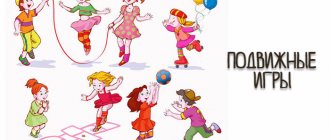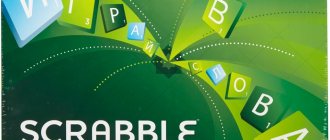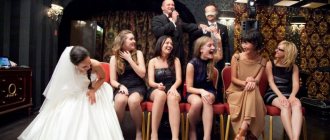Two in one
A fun competition for clever and smart teenagers. The guys are divided into pairs. Each couple receives tights or pants and a pair of shoes (any), most importantly, with laces. At the command “start,” the guys cooperate and put on their pants: in one pant leg the right leg of one participant, and in the other leg the left leg of the second participant. As soon as the couple puts on their pants, they begin to wear shoes. And here it is important not to get confused, because the right boot or boot should be on the left foot of the first participant, and the left boot or shoe should be on the right foot of the second participant. The couple puts on their shoes and ties their laces. The first couple to put on their pants, put on their shoes and tie their laces will be the winner.
Street twister
Cool, right? You yourself determine the size of the playing field and the size of the colored circles depending on the age of the participants. To make it more comfortable for children, the circles can be made smaller. Preparing this is all very simple: the easiest way to draw on asphalt is with colored chalk (in order not to get your hands dirty, just outline the contours of the circles and do not paint them completely). If you're willing to risk your lawn, there are water-based paints available that will wash off in the rain. A cardboard box with a corresponding hole cut in the bottom will help you draw circles of the same size.
Typical teenager
Guests of the celebration are divided into teams with the same number of participants (approximately 5 people each). Each team stands in a circle. All teams are given a pack of chips and a bottle (0.5) of Coca-Cola. At the “start” command, the first participants open a pack of chips and eat one chip, open a bottle of cola and take one sip, then pass the drink and food to the second participants. The second participants also eat one chip and take a sip of cola each and pass it on to the third. The team in which the guys eat chips and drink cola the fastest will be the winner.
Calm games
Hands up
| Preparation | Exercise |
| The players are divided into 2 teams, each of which is seated on one side of the table. | The captains sit on the edge. One of them has a coin, which must be passed on to the next players unnoticed by the opponents. Thus, the coin moves from hand to hand from one participant to another until the opposing captain shouts “Hands up!” The first team players raise their hands clenched into fists. After this, the opposing captain says “Hands down!” Participants place their hands on the table with their palms facing down, trying to prevent the hidden coin from clinking. Any two members of the opposing team guess the location of the coin. If they determine correctly, then the coin is sent to them. If not, it stays with the first team. |
What else to read: Sports relay races “Strong, Agile, Fast” - scenario for celebrating February 23
Dealer
| Preparation | Exercise |
| Each participant receives 10 coins. | Players pocket the coins, leaving a few in their fist. After this, they approach other participants and they guess how many coins are clutched in the opponent’s fist. If the player guesses correctly, the opponent gives the coins to him. If he calls the wrong number, he will have to give the opponent the difference between the named and the actual number of hidden coins. For example, the opponent hid 3 coins, and the player called the number “5”. In this case, he must give 2 coins. The one who collects the most coins wins. |
Guess
| Preparation _ | Exercise |
| Participants are given a piece of plasticine or clay. A hat is placed in the center: it contains pieces of paper with the names of various animals. | Participants take turns pulling out a piece of paper, reading what is written on it, and then making an animal out of plasticine. After 2 minutes, they show what happened, and the rest of the players guess what was written on the piece of paper. Whoever guessed correctly gets a point. The participant with more points than the rest wins. |
Zeeb. Zeb. Zab.
I heard about this game for the first time from my children; I had never played it before. This fun helps develop reaction speed and observation.
- Again, the players stand in a circle.
- The first player sharply throws his hand out in front, pointing at someone standing in the circle and says loudly: “Zib!”
- The player pointed to by player number one also sharply throws his hand forward, points to someone else and says the word “Zeb!”
- This third player again points at someone with a sharply thrown out hand and says: “Zab!”
- And so on: “Zib! Zeb! Zab! Zeeb! Zeb! Zab!..” It is important that this series is not broken.
This game seemed very simple to me. But Alexandra said that everything is not as simple as it seems. Firstly, you can gape and not notice that they pointed specifically at you. And secondly, you can (and this happened often) say instead of “Zib”, for example, “Zab”, that is, get out of line. The one to whom this happens is eliminated from the game.
Where is the coin
A game aimed at developing observation skills. So, all players stand in a circle and join their palms in this way.
The right palm lies on the left palm of the player standing on the right, and on the left palm of the player lies the right palm of the player standing on the left.
If the previous sentence is not clear, try re-reading it again or twice.
- First, the presenter goes out the door, and one of the players takes a coin in his hand and hides it in his palm.
- When the host returns, the game participants begin to pass the coin to each other clockwise. From hand to hand. From palm to palm.
- The presenter’s task is to determine who is currently holding the coin in their hands.
Everything would be very simple if not for one thing. The fact is that the movement of the hands is performed not only by the one who currently has the coin, but by all participants in general. That is, it seems that each player has a coin and they all pass these coins to the neighbor on the left.
If the leader determines the correct coin holder, then that player becomes the leader, and the leader stands in a circle.
Frog
This game is somewhat similar to the previous one.
- Everyone stands in a circle.
- The presenter goes out the door.
- The players, while the leader is not present, agree on which of them will be the “frog”. The leader returns and stands in the center of the circle. His task is to determine who is assigned to the role of “frog”.
- What is the frog doing? The frog shows his tongue (sticks it out and puts it back in). But she does this only when the presenter is not looking at her, for example, when he turns his back to the “frog”. Well, when the one who drives turns to face the “frog”, then she tries not to give herself away in any way.
It happens that the presenter turns around precisely at the moment when the “frog” has not yet had time to hide his tongue.
It happens that the “frog” is given away by the looks of other participants in the game who are looking at it. So here the presenter needs to be very careful and learn to read faces, the “frog” needs to be careful not to get caught, and the rest of the players need to remain calm.
Don't touch me!
- The players stand in a circle, holding hands tightly.
- In the middle of the circle, pins are placed in a random order, approximately 50 cm from one another.
- At the judge’s signal, each player, without unclenching his hands, tries to push his neighbors onto the pin.
- As soon as the first pin is knocked down, the game pauses. The pin is set again, and the player who knocked down the pin is eliminated from the game.
- The rest, holding hands, resume the game at a signal.
It should be remembered that pushing is allowed only with your hands, without letting go of your neighbors’ hands. And one more thing: if a player, without dropping the pin, breaks the chain three times (by releasing his hand), he is eliminated from the game.
Towards the end of the game, when the number of participants becomes small, you can reduce the number of pins and the distance between them.
Throw it, don't stop
The guys are divided into 2-3 teams of about 5 people. Each team chooses a captain, who must stand with his back at a certain distance from his team. Each captain receives a package of identical items, for example, bouncy balls, small balls, coins, and so on). At the command of the leader, the captains begin to throw objects behind their backs one at a time, and the team must catch as many of these objects as possible and only from their captain. As soon as the host stops the game, an honest count is made. The guys who collect the most items thrown by their captain will become winners and receive a prize.
Falling tower
Friedamischke/Depositphotos.com
Everything is clear here: we take turns removing the blocks, and whose tower collapses is the loser. Actually, only the blocks are needed for the game. Approximate length - 25 cm, total quantity - 48 pieces. At a hardware store, you buy fairly thick boards, saw them and sand them, and then there are options: you can leave them in their original form, or you can paint them (only the ends, the whole board, or even paint them with patterns).
Treasure Hunt
tobkatrina/Depositphotos.com
Unfortunately, today children spend little time outdoors, but this game will correct the matter. We are making a list of treasures that players will need to collect. Cones, different types of flowers, leaves, twigs of unusual shapes, something round, triangular or square, objects red, green or yellow. We print out these lists and stick them on paper bags, and hand the bags over to the rangers. The first one to collect all the items from the list wins.
wampum
Do you know what wampum is?
Wampum are cylindrical beads strung on cords that served the North American Indians for various purposes.
well, now you know)
The role of wampums was played by small pieces of paper, which were tied to strings and placed around the necks of the players.
Everyone is divided into two teams. And at the signal they begin to play. The task is simple. Rip wampums off your opponents and prevent them from ripping off their wampums. The team whose player remains last with wampum around his neck wins.
If you think about it, it becomes clear that you can win this game if you develop cunning team tactics and choose one of your players, who will be protected by everyone else from the attacks of the enemy team, while simultaneously trying to pick wampums from their opponents.
But of course it’s difficult to understand this the first time. So everyone acted alone. As a result, Sashulya was the first to lose her wampum) By the way, there is a small piece of video from this outdoor game.
Club "Fujiyama"
So, we have a Fujiyama club in Lipetsk. There, children are taught various martial arts, dancing, chess and other interesting things. I enrolled my youngest son Artem in this club, he goes to aikido. Denis looked at Artem and also wanted to take up this sport. So now we have two aspiring Aikido practitioners in our family)
And one day, the club administrator Anna told me that it was planned to open a “School of Leaders” on the basis of the club. I immediately thought about my Sashka, since this is exactly what she (with her irrepressible energy and desire to organize everyone) needs.
And so, this Sunday, Fujiyama held an open day. Where everyone who wanted to attend the “School of Leaders” could learn more about what it is. The children came with their parents. I was at work, so my children went there on their own.
For adults, a meeting was arranged with a psychologist who talked about how to communicate correctly with children, how to help them study, about other important things and answered questions of interest.
Well, the kids, all mostly aged 10 years and older, went to the next room with their instructor Petya in order to get to know each other and learn new interesting games.
As far as I understand, the games were selected taking into account the fact that this is, after all, a “School of Leaders”. Each of them is aimed at developing a specific skill that will certainly be useful in life to any person, and especially to a leader. In two hours we managed to play seven games, which I want to present to you.











